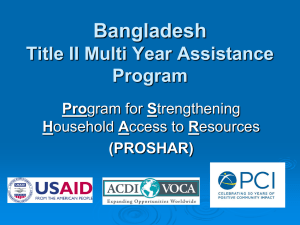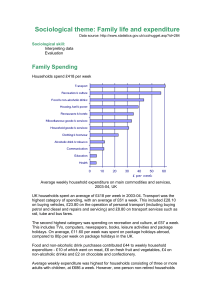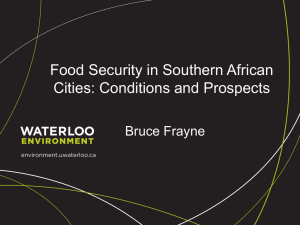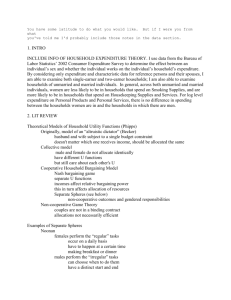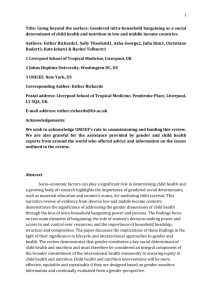Jacobs Diverse HH Food Access
advertisement
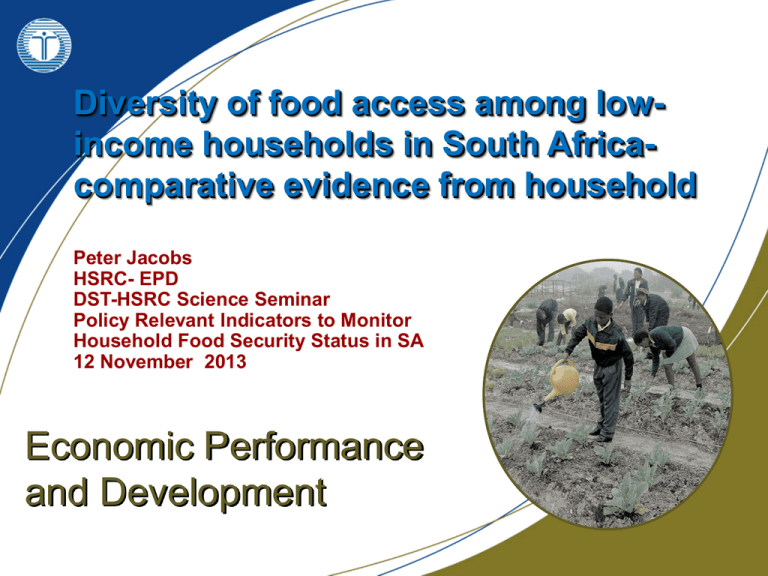
Diversity of food access among lowincome households in South Africacomparative evidence from household Peter Jacobs HSRC- EPD DST-HSRC Science Seminar Policy Relevant Indicators to Monitor Household Food Security Status in SA 12 November 2013 Economic Performance and Development Food & Nutrition Status of SA Households- debunking old myths • Reduce and restrict SA food insecurity problem to aggregate (economy-wide) food production • Other dimensions of food security (such a food access) receive almost no attention despite ‘overwhelming dependency on access to food through markets’ • Food insecurity is a ‘rural problem’- downplay or ignore differential livelihood capabilities (small-farm households, farm workers, urban/rural, informal settlements, etc…) • SA Food & Nutrition Security debate far more nuanced major food system transition and shifts… Where Households Purchase Foods, Rural versus Urban, IES 2010/11 (%) Fresh Fruits Fresh Vegetables Meat Retail Outlet Urban Rural Urban Rural Urban Rural Chain Stores /Supermarkets 59.33 26.2 29.64 9.91 56.37 33.12 Other Retailers 16.26 52.28 43.2 43.03 36.72 47.46 9.3 12.67 9.79 14.09 0.75 1.35 15.11 8.85 17.38 32.97 6.16 18.06 Street Traders Other Month, YEAR May-12 Jan-12 Sep-11 May-11 Jan-11 Sep-10 May-10 Jan-10 Sep-09 May-09 Jan-09 Sep-08 May-08 Jan-08 Sep-07 May-07 Jan-07 Sep-06 May-06 Jan-06 Sep-05 May-05 Jan-05 Sep-04 May-04 Jan-04 Sep-03 May-03 Jan-03 Sep-02 May-02 Jan-02 Sep-01 250 PPI-Agric CPI-General CPI-Food 150 80 100 60 40 50 20 0 0 CPI Value 100=2008 200 May-01 Jan-01 Sep-00 May-00 Jan-00 PPI Value, 100=2005 Three waves of food price inflationinsufficient access to food? Inflation trends based on PPI and CPI, Jan 2000- June 2012 140 PPI-General 120 PPI-Agro-Food 100 Food price inflation, affordability & household food & nutrition status • Limited high-level picture based on PPI and CPI trends; unpack drivers of food costs/affordability across agrofood value chains • Wave 1: Jan 2001-Jan 2003 • Wave 2: Sep 2006-Jan2009 • Wave 3: Aug 2011-May 2012 • Investigate dominant features of food and nutrition security crises; develop a typology: • how vulnerable and at risk households respond (coping strategies?); • how government, private sector, civil society and other stakeholders counter the adverse impacts of crises- immediate and longer-term responses / interventions? Some puzzles emerging from food price crises? • Are households switching to more affordable food options? • Lower-cost but healthy (awareness question?) • Cheap with poor nutrition (spending decision?) • Objective economic and subjective decisions intertwined- tricky to disentangle… Substantial changes in household food security questions/info in GHS, 2007 versus 2010/2012 Food security status GHS 2007 Hunger scale (Adults/children) Farm workers; Small-farm households; Household size Total spending (quartiles); Living standardsFood spending; expenditure Social grants Agricultural production Land access; Agricultural outputs Provinces; Spatial information District councils Household livelihoods & demography GHS 2010 Hunger scale (adults/children); Food access; Variety foods consumed; Coping strategies Farm workers; Small-farm households; Household size Total spending (quartiles); Social grants; Farm activities; Agricultural outputs Provinces; Rural categories (formal/exhomeland) Food insecurity based on hunger scaleGHS 2007-2012 2007 Hunger scale Never Seldom/som etimes Often/alway s N (HHs) 2010 % N (HHs) 2012 % N (HHs) % 11,159,150 86.48 11,421,362 81.35 11,996,295 83.28 1 489 289 11.54 2 196 361 15.64 1,996,636 13.86 255 795 1.98 422 467 3.01 411,565 2.86 IES 2010/11 Data Issues • IES sample: Master Sample PSUs + 174 urban PSUs (2001 Census) • Information about expenditure items: classification of individual consumption according to purpose (COICOP); reference period= 12 months • Diary method renders a more complete understanding of a household's acquisition patterns- greater accuracy • Some evidence on where households buy virtually all their food items Average Annual Household Spending on Food, IES 2010/11 Food Items Bread & Cereals Meat Fish Dairy Eggs Fats & Oils Fresh Fruits Dried Fruit & Nuts Processed Fruits Fresh Vegetables Processed Vegetables Sugars & Sweets Processed, Salts & Food Hampers Beverages: Tea & Coffee Soft Drinks & Fruit Juices URBAN RURAL TOTAL 841.38 1042.3 1411.6 1302.7 718.13 383.38 583.81 695.22 1151.2 630.19 323.35 660.87 233.55 114.16 52 78 472.86. 173.22 379.36 559.15 526.72 244.38 366.11 906.76 1360.7 606.7 637.32 898.03 518.71 204.97 69.08 472.86 320.58 546.28 288.14 11364 759.89 512.58 9649.9 661.32 430.9 7649.3 91 357.19 IES 2005/06- Diverse access to food (Aliber 2009) • ‘IES does pick up significant differences in the diversity of their diets, and by implication of the quality of those diets’ • ‘small-scale agriculture would appear to account for most or all of the gap observed in food expenditure per capita between rural and urban households’ • “…household-level food security comprises distinct dimensions, such as frequency of having ‘enough food’, and the nutritional quality of the diet” (Aliber 2009: 405) National Income Dynamics Survey- W2 • Food Expenditure at the household level • Household consumed food in last 30 days- binary response • Value of HH consumption- no units of consumption • Nutritional markers: BMI scores, child health indicators • Therefore linkage between household food access status and individual nutritional status Average Household Expenditure on cereals 30 days pre-survey, NIDS Wave 2 RuralRuralUrbanUrbanFood Item formal Tribal Informal Formal Maize 122.62 105.32 58.03 57.17 Samp & Beans 33.14 41.66 29.15 35.23 Bread 91.87 81.25 72.48 104.09 Spending Share 0.4 0.45 0.42 0.3 Total Food Expenditure 949.75 776.39 731.1 1477.9 Total HH Exp 3568.2 2330.7 2076.2 8633.7 Access to Diverse Food- rapid household framework & indicator [HFAD]? FOOD GROUP DIVERSITY NARROW HIGH FOOD SPENDING LOW SHARE WIDE 1 3 2 4 Missing link 1- who must be prioritised in food and nutrition policy? • Prioritise the needs to those without adequate food and nutrition • Translate constitutional provision into appropriate policy and efficacious programmes • Inseparable from global & local right to food debates/campaigns- example UN/FAO, India’s new Food Security Law, etc. • Falling into food & nutrition insecurity easier than transitioning out of it- extreme vulnerability problem? • Food price crises: 3 waves of rapid food price inflation • Global economic downturn (working poverty pathway…) • Begin to explore intra-household and individual food & nutrition security Missing link 2: Improve our food and nutrition measurement tools and methods • Invest in high-frequency and low-cost tools to map the food and nutrition status of households/individualsSANHANES-1 +++ • Better measurement of household food security status • Indicators for multiple facets of food & nutrition security (include access, consumption) • Richer nationally representative datasets- with reliable least district level information • Scope for improvements and high-frequency M&E tools • Further research required how food access relates to dietary diversity and ‘coping strategies • Caveat- mixed livelihood strategies impossible to investigate because surveys exclude primary and secondary sources


